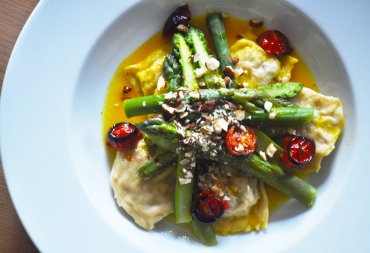It’s still the season for British asparagus (and yes, I believe it’s running slightly late this year, along with much of nature). Today we used up some local asparagus spears to accompany a homemade ravioli filled with a mix of black salsify, hazelnuts and ricotta. It’s a variation on a theme by our old favourite Denis Cotter, with a few ingredients changed, and it was rather delicious. I’ll write up more about homemade pasta soon but in the meantime, here’s what we did for this dish.
Serves two.
First, the ravioli filling: preheat the oven to 180c. Peel and dice around 100g of black salsify and boil in a small saucepan until tender. Scatter the salsify on an oven tray and place it in the warm oven to ‘dry out’ a little for around 10 minutes (you don’t want a soggy filling in your ravioli). After removing it, mash it with a fork. Leave the oven on.
Blitz 25g of hazelnuts in a food processor and transfer to a bowl, mix in the salsify mash, a large dessert spoon of ricotta, a large pinch of grated or ground nutmeg, season with a little salt and pepper and combine well. Set aside.
Now for a little ‘sauce’: squeeze the juice of half a lemon into a small pan, add some strips of lemon peel and 50ml of white wine plus a pinch of saffron strands. Bring to a simmer and let it cook for 3 minutes. Remove the strips of peel and add around 30g of unsalted butter. Stir until it melts. Keep this warm, but don’t let it boil.
Filling the pasta: a general way of making the ravioli is with two equal size sheets of thinly rolled pasta dough. Take the first and carefully place teaspoons of the filling on it, around 2.5cm apart. Brush the pasta with water or egg wash and place the other sheet on top. Press it down, making sure there are no air bubbles. Now use a ravioli cutter or knife to cut out square ravioli.
The asparagus: we used thick spears, woody ends snapped off, cut lengthways. Thinner ones can be left whole.
The tomatoes: slice a handful of cherry tomatoes in half and place them on an oven tray, drizzle with olive oil, season with a little salt and place in the oven.
Now bring it all together. First put the asparagus in a saucepan of boiling water and simmer for around 5 minutes until just tender. As it’s cooking, cook the ravioli for around 4 minutes in a large pan of salted water. Drain, return to the pan and add the lemon butter. Stir.
To serve, place the ravioli in wide bowls, place the asparagus on top, pour over any remaining lemon butter, add the tomatoes and finish with a scattering of chopped hazelnuts.









Last Night’s Dinner: Brussels Sprouts with Gnocchi, Roasted Shallots and a Blue Cheese Sauce
Oh Brussels sprouts! Every Christmas it’s the same isn’t it? Everyone has them, everyone hates them.
Well, actually, here at ETP Towers we rather like them. Recently, in fact, we’ve been eating them with pasta. For New Year’s Eve, Ella decided to make this rather rich dish from goodly Cork chef Denis Cotter of Cafe Paradiso fame. The problem was, we were both rather ill and the heady combination of greens, blue cheese, roasted onion and soft, cheesy gnocchi felt too much for us. After doing half the prepping we called time and put the ingredients aside.
Luckily we were feeling better the following day and carried on where we left off. It’s a great recipe and the combination of potatoes, greens and a cheese sauce, while hardly revolutionary, takes on some extra nuances through the choice and ways of cooking the ingredients.
You want the recipe? Well, it’s not ours, it’s Den’s, so you’ll need to look here.
Or you could have a go yourself. A creamy blue cheese sauce? A five-minute job. Roasted shallots? Get the oven on. Cheesy potato gnocchi? If you haven’t tried making gnocchi, look it up, it’s easy. And the sprouts? Just remember not to boil them.
Posted in Cheese, Chefs, Comment, Greens, Italy, Last Night's Dinner, Onions, Potatoes, Veg in season | Leave a Comment »